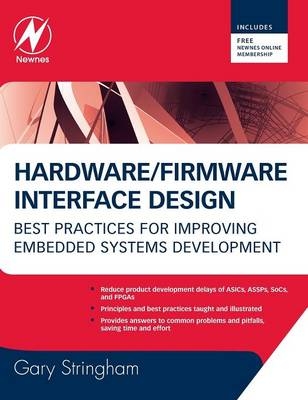
Hardware/Firmware Interface Design
Newnes (an imprint of Butterworth-Heinemann Ltd ) (Verlag)
978-1-85617-605-7 (ISBN)
Why care about hardware/firmware interaction? These interfaces are critical, a solid hardware design married with adaptive firmware can access all the capabilities of an application and overcome limitations caused by poor communication. For the first time, a book has come along that will help hardware engineers and firmware engineers work together to mitigate or eliminate problems that occur when hardware and firmware are not optimally compatible. Solving these issues will save time and money, getting products to market sooner to create more revenue.The principles and best practices presented in this book will prove to be a valuable resource for both hardware and firmware engineers. Topics include register layout, interrupts, timing and performance, aborts, and errors. Real world cases studies will help to solidify the principles and best practices with an aim towards cleaner designs, shorter schedules, and better implementation!
Gary Stringham is the founder and president of Gary Stringham & Associates, LLC. He has 30+ years of experience in the embedded systems industry, assisting clients in their product development and engineering training. He has extensive expertise in diagnosing and resolving a broad range of engineering problems, including: helping litigation clients understand technical aspects of case; working on the design, implementation, and testing of solutions involving software, hardware, and firmware. Gary previously worked for Hewlett-Packard Company, where he developed and maintained several device drivers controlling a variety of blocks on various ASICs and SoCs for HP LaserJet printers. This involved diagnosing chip problems when they occurred and designing and developing firmware workarounds. Gary helped develop various tools used for the development, testing, and manufacturing of HP-UX workstation and LaserJet printer products. For a printer emulator tool, he developed the board design, the FPGA code, the firmware running on the tool, and the software running on the host computer. In one instance, the emulator reduced a 40-hour manual test to a 35-minute automated test. For a manufacturing test tool, he architected the tool, led a team of 10 engineers to develop it, and deployed it at five manufacturing sites world-wide. Gary is a Senior Member of IEEE. He holds a BSEE from Brigham Young University and an MSEE from Utah State University.
Chapter 1 - IntroductionChapter 2 - Principles Chapter 3 - Collaboration Chapter 4 - Planning Chapter 5 - Documentation Chapter 6 - SuperblockChapter 7 - Design Chapter 8 - Registers Chapter 9 - Interrupts Chapter 10 - Aborts, etc Chapter 11 - Hooks Chapter 12 - Conclusion
Appendix A: Best Practices Appendix B: Bicycle Controller Specification Appendix C: Using this Book in a University (only available online at http://www.elsevierdirect.com/companion.jsp?ISBN=9781856176057)Appendix D: Glossary Index
| Verlagsort | Oxford |
|---|---|
| Sprache | englisch |
| Maße | 191 x 235 mm |
| Gewicht | 940 g |
| Themenwelt | Mathematik / Informatik ► Informatik ► Theorie / Studium |
| ISBN-10 | 1-85617-605-3 / 1856176053 |
| ISBN-13 | 978-1-85617-605-7 / 9781856176057 |
| Zustand | Neuware |
| Haben Sie eine Frage zum Produkt? |
aus dem Bereich


